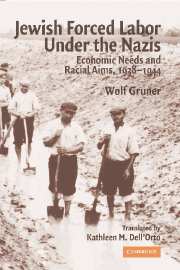Book contents
- Frontmatter
- Contents
- Abbreviations
- Introduction
- Prologue: Anti-Jewish Policies in the Nazi State before 1938
- GERMANY
- AUSTRIA
- THE PROTECTORATE OF BOHEMIA AND MORAVIA
- THE OCCUPIED TERRITORIES OF POLAND
- 6 Camps and Ghettos – Forced Labor in the Reich Gau Wartheland, 1939–1944
- 7 On the “Führer's Road” – Polish Jews in Germany, 1940–1943
- 8 The SS Organisation Schmelt and the Jews from Eastern Upper Silesia, 1940–1944
- 9 The Labor Office versus the SS – Forced Labor in the General Government, 1939–1944
- Conclusion
- Index of Subjects
- Index of Persons
- Index of Places and Camps
6 - Camps and Ghettos – Forced Labor in the Reich Gau Wartheland, 1939–1944
Published online by Cambridge University Press: 05 June 2012
- Frontmatter
- Contents
- Abbreviations
- Introduction
- Prologue: Anti-Jewish Policies in the Nazi State before 1938
- GERMANY
- AUSTRIA
- THE PROTECTORATE OF BOHEMIA AND MORAVIA
- THE OCCUPIED TERRITORIES OF POLAND
- 6 Camps and Ghettos – Forced Labor in the Reich Gau Wartheland, 1939–1944
- 7 On the “Führer's Road” – Polish Jews in Germany, 1940–1943
- 8 The SS Organisation Schmelt and the Jews from Eastern Upper Silesia, 1940–1944
- 9 The Labor Office versus the SS – Forced Labor in the General Government, 1939–1944
- Conclusion
- Index of Subjects
- Index of Persons
- Index of Places and Camps
Summary
EXPULSION PLANS AND FORCED LABOR AS AN INTERMEDIATE SOLUTION
Forced labor had been a basic component of Jewish policy in the Reich before the war, and it was to become an element of war and occupation thinking as well. In September 1939, the Nazi state started the war with Poland. After the quick defeat of the Polish state, it became clear that the forced-labor plans discussed at the end of February could not be implemented as projected in Germany, Austria, or the Protectorate: The Nazi leadership had very hastily made a new, fundamental decision to deport all the Reich's Jews to Poland in the near future. On September 14, 1939, Heydrich announced that Himmler would put forward proposals shortly that “only the Führer could approve because they would have significant implications for foreign policy.” On September 19, the Council of Ministers for Reich Defense, including Göring, Heydrich, Frick, and State Secretary Syrup from the Reich Ministry of Labor, conferred on the “population of the future Polish Protectorate and accommodation of the Jews living in Germany.”
On September 21, 1939, at a meeting with the Security Police office chiefs and Einsatzgruppe leaders, Heydrich provided an overview of the planned course of events in Poland. The former German provinces were to become German Gaue, and a Gau for speakers of foreign languages would be created on the remaining Polish territory. According to Heydrich, Hitler had authorized the Jews' deportation to the latter Gau.
- Type
- Chapter
- Information
- Jewish Forced Labor under the NazisEconomic Needs and Racial Aims, 1938–1944, pp. 177 - 195Publisher: Cambridge University PressPrint publication year: 2006



